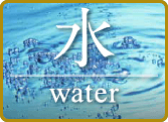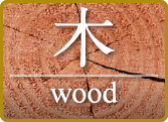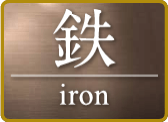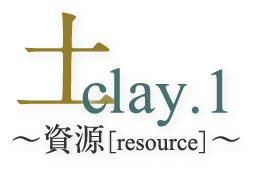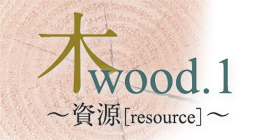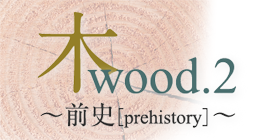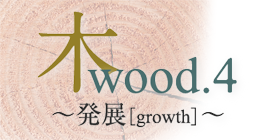A trip to the origin of MONOZUKURI
Cars, aircraft, industrial machinery, and ceramics.
Shoryudo in which all of the manufacturing industry's leading companies are gathered is truly the ‘heaven of MONOZUKURI.
The main characteristic is that there are so many different fields of manufacturing located here. Likewise, the scale of the companies supporting these industries is also very extensive.
With plenty of resources, and the fact that it is located in the heart of Japan have both contributed to the long history of MONOZUKURI of this area.
Well, let’s dive into the source of Japan’s MONOZUKURI heaven.
TOP > Features

Four of ‘Japan’s six old kilns’ are located in the Shoryudo.
One is located in both Seto and Tokoname city in Aichi prefecture, one in Echizen city in Fukui prefecture, and one in Shigaraki city in Shiga prefecture.Why have these areas produced so much of Japan’s pottery?

The large lake that produced superb quality clay
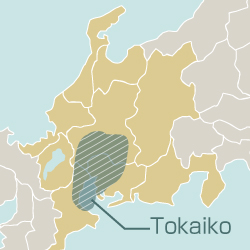
The largest producers of pottery are the Aichi and Gifu prefectures. The reason for this is because the resources for making pottery were found in this area.
Around 5 million years ago, there was a huge lake called ‘Tokaiko’ around this area. In that lake vast amount of clay and mud were accumulated, which soon after led to this area being the largest producer of high-quality potter’s clay, after which pottery production really started taking off.

Japan’s largest producing area of ceramics and pottery in the Middle Ages
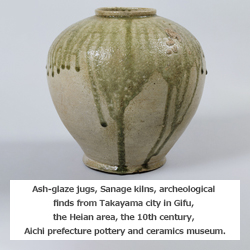
In the 6th century, thousands of new kilns were built in the area of the Sanage-kiln in Aichi prefecture, which not later produced the first ash-glazed pottery of that time.
The technology spread to the cities of Seto and Tokoname, which led to this area becoming the leading manufacturer of pottery in Japan. The kilns in Echizen and Shigaraki were also influenced by this technology around the 12th century, and started to produce ash-glazed pottery of their own.

The making of pottery that opened the way to the tea ceremony
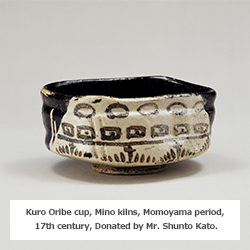
In the 16th century the tea ceremony spread across the country. At the same time, Japan’s pottery industry was influenced by pottery from China and Europe, which led to the birth of a new type of pottery which was produced by more refined glazing and firing techniques.
Two examples are the ‘yellow seto’, with its unique tints, and the beautiful‘black seto’.The ‘Sino’ pottery with its thick and white glaze, and the ‘Oribe’ pottery with its original form and green glaze are just some of the examples which fascinated military commanders and wealthy people of the cities of that time.

The ‘Hakuji’ porcelain born out of hardship
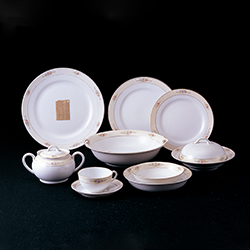
An independent merchant who travelled to the Paris exposition in 1889 and came in contact with many beautiful porcelain pieces established a company in Japan to produce the same porcelain in Japan. And so, in 1904, in Nagoya city, which is in close proximity to Seto city, he founded Japan’s first modern factory for the production of porcelain and ceramics.
After much trial and error in mixing the raw materials and creating different shapes, the company succeeded in creating exquisitely beautiful and rigid white porcelain. In 1914, Japan’s first Western-style dinner set was launched.

The fine ceramics that led the industry of the 21st century

Not long after, the porcelain and ceramic manufacturing companies established many other companies to produce products like sanitary ware, and they continued to grow and thrive as a world-renowned maker of ceramics.
From old pottery to 21st century ceramics. Shoryudo harbors many manufacturing companies. We can place great hope on these companies to use ceramics to advance possibilities in medical, electrical, biotechnology, and environmental fields.

Water is the source of life.
Water moisturizes farmland, creates energy, and even became a way for people and goods to be transported.
Let’s dive into the story of the water that supports the various industries.

The flow of the river through dynamic terrain
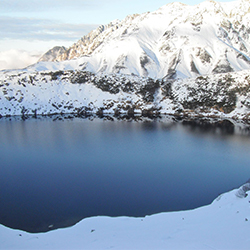
The 3000 meter tall mountain range of Tateyama and the forest that takes up about 70% of the prefectures land area are the source of Toyama prefecture’s water.
In the spring the snow turns to water, and the forest absorbs that water in the piled up fallen leaven on the ground. Because of the severe differences in altitude, the river that has become the world’s famous for its fast currents, has made the point where the mountains reach the plain fields into a beautiful alluvial fan-shaped valley.

Keeping water in place by use of flood-control technology
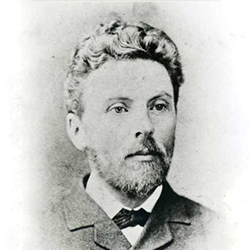
Fast-flowing rivers sometimes overflow. In order to prevent flood damage, embankment and improvements to the rivers have been carried out since the 15th century.
In the Edo period(1603-1867) newly reclaimed rice fields increased by using water drawing technology. In the Meiji period(1868-1912), with the guidance of a civil engineer from The Netherlands called Johannis De Rijke, new technologies to effectively use water were developed, and hydroelectric power generation use prospered.

Toyama prefecture, Japan’s number one hydroelectric power generator
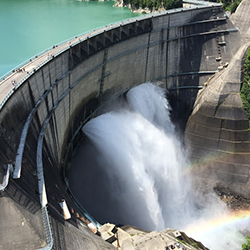
The most important dam in Toyama prefecture is the Kurobe dam. A mega project that took more than 7 years and 10,000,000 million people to complete. It is called one of the great constructions of the century.
With a height of 186m, it is Japans’ tallest dam, and its flooded area covers more than 200 million ㎥, which is about the equivalent of 1000 super large oil tankers. The amount of electricity this dam produces is around a billion kWh a year. This electricity supports the agricultural and industrial industry in this area.

Delicious seafood, delicious rice and water
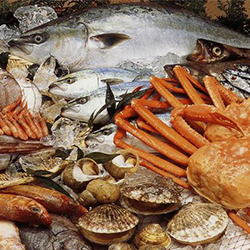
It is said that the reason why the seafood of the bay of Toyama is so good is because of the abundance of nutrients of the forests that is carried to the sea by the many rivers.
Also, because the area around the rivers has become fertile due to flood control, Koshihikari rice, jumbo watermelons, tulips and other agricultural products have been able to grow there. Sake, miso, tofu, and even mineral water have become some of the special products produced there.

Focus on highly-technological water utilization

With hydroelectric power generation as a basis, big companies in spinning, chemistry, mechanical and other industries are also making progress.
From traditional pharmaceuticals and fiber to resin, precision mechanical equipment and others, various industries in Toyama prefecture are finding locations to make use of the power of hydroelectric power generation.
Currently, aluminum sashes (for use in windows, etc.), which is currently the most exported product in Japan, and many other highly advanced water technologies like water-powered cutters and surgical scalpels are currently gaining a lot of attention.

The wood that the bountiful forests produced has become the foundation for many industries.
From traditional tableware to aerospace equipment, the technological history of wood is impressive.

The climate of Kiso that nurtured excellent cypress trees

There have always been many natural forests with needle-leaved trees like cypress in the Kiso area of Nagano prefecture. The cold climate in that area produced sturdy trees with very fine age rings.
These trees got a lot of attention from around the 8th century, when they were used in Buddhist statues, shrines and temples, and for the construction of castles in the time of the samurai.

The wood that was transported along the river to the seashore
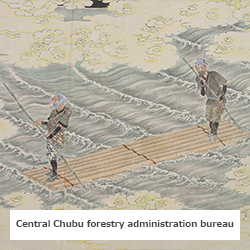
When the supply of these trees was beginning to become run dry due to a boom in construction in the early Edo period(1600's), the Owari domain decided on a strict protection policy for the Kiso forests.
While the protected, beautiful cypress trees were being grown, the citizens of that area were gifted with Shiraki wood from those very trees (this was material that was deemed fit for use as semi processed goods), which led to a boom in combs’, hats, geta, tableware, lacquerware, and more.
Also, the tree logs which were led along the Kiso river were turned into rafts mid-stream, and consequently brought to what we now know as Nagoya city.

From mechanical dolls to the clock market

The abundance of timber caused woodworking technology to thrive.Mechanical dolls made to work with wooden cogs and springs and mechanical dolls on festival cars made and used in the Edo period(1603-1867) are still used to this day in the region.
Also, the wall clocks from Nagoya, which were both cheap and filled with technology with wooden boxes and springs, were exported to China and the rest of Asia around 1890.

The roots of car manufacturing lie in the wooden loom
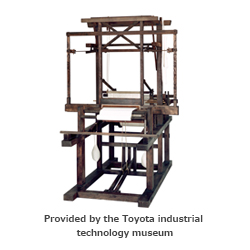
Japan’s largest car manufacturing company was established by the invention of the wooden Toyoda-style human-powered loom by its founder. In 1936, his son started producing automobiles.
The first cars had their test designs made from wood.
Also, in 1893, a timber company founded the Aichi Tokei Company, which later produced precision equipment and aircrafts.

The expectations of human-like robots
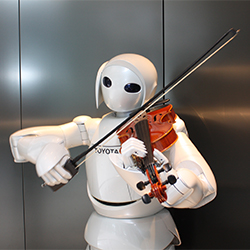
The fact that in Japan not only industrial, but also human-like robots are being produced on such a large scale is certainly partly due to the mechanical dolls influence.
Also, the techniques behind the mechanical dolls evolved, and their use went from being used in clocks to being used in precision equipment, which in turn led to developments in aerospace engineering.
Now, the Chubu area is producing 50% of aircraft parts in Japan. And there are great expectations for Japan-made jet-engines and rockets.

Beautiful silk threads and simple cotton threads.
The cloth that derived from those threads has warmed and enriched the lives of many people.
Let’s unravel the return of the textile industry of Japan.

The hemp, cotton, and sericulture fibers
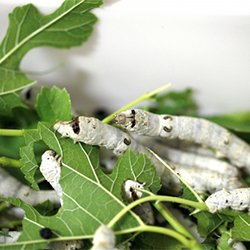
In Fukui prefecture, ropes are being excavated from ruins over 10,000 years old. The material used to make these ropes was hemp.
The silkworms which form the basis for raw silk fibers were introduced by the Chinese around 300 B.C., after which they spread throughout the entire country. Also, cotton fibers were introduced to the area of Nishio, in Aichi prefecture, around 800 A.D. by Indians who had drifted ashore. However, apparently the climate was not suitable for growth, and it did not take root.

Japan, the world’s leading export of raw silk
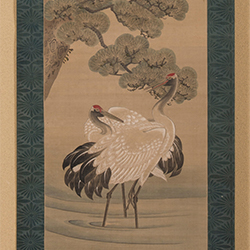
In the Edo period(1603-1867), Japan imported vast amounts of raw silk from China. The government consequently encouraged the use of silkworms. After this, among other things the skills of dyeing were developed (Kagayuzen).
In the Meiji period(1868-1912), the industrialization of silk spinning was further developed in the Nagano prefecture and other regions, and around the 1900’s Japan had become the world’s biggest exporter of raw silk. The United States became the largest export destination for Japan. From the United States, foreign capital was consequently invested in facilities and equipment, which supported the industrialization of Japan.

The rise and fall of Japan’s cotton industry
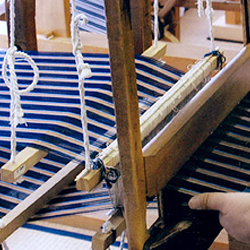
Around the 16th century, both the cultivation of cotton, and the advancement of new technology spread in Japan. The sturdy cotton cloth was used in the clothing for the samurai, and the cultivation of cotton grew rapidly in the Mikawa and Chita areas (Isesarashi and Matsusakasarashi).
The export of cotton also grew, but in the middle of the Meiji period(Around 1900), Japan began to rely on the cheap price of foreign raw materials for the spinning machines, which eventually caused Japan’s own cotton farmers to go out of business.

From natural fibers to chemical fibers
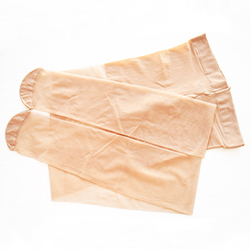
Around 1940, the United States began the export of nylon stockings to other markets. At the same time, cotton cloth from other Asian countries also flood the Japanese market, which caused a massive decrease in Japanese cotton cloth production.
At the same time, the production of artificial silk thread called Rayon was started in 1915 in Mie prefecture, and soon spread to Yamagaka prefecture. Nylon fiber production started in 1951, and this is also the time when acrylic fiber was introduced.

The start of a new era in fibers

Fibers used for industrial materials are gaining a lot of attention these days. Among these, especially carbon fiber, which is 10 times as strong with 1/4th of the weight of iron, is gaining a lot of attention. Because of its lightness and strength it is widely being used in the medical and sports sector, airplanes, and much more.
There are companies that are expanding their facilities in Ishikawa prefecture to produce a line of new products produced with carbon fibers permeated in resin. There are also companies that supply materials for passenger planes. Companies are constantly searching and getting ready for a future with new possibilities and new uses for this material.

By obtaining and utilizing iron, great leaps and bounds have been made in the manufacturing industry, leading to a change in the daily lives of many people.
Let’s dive into the history of what fundamentally supports society. Let’s look at the history of iron.

The long history of foot-operated bellows
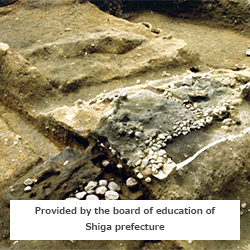
It is believed that around 300 B.C. both ironware and the techniques for rice cultivation were introduced to Japan at around the same time from the mainland. Not long after that, food-operated bellows which used iron sand and charcoal as primary materials were invented, and continued to operate up until the early modern times.
Iron sand was mainly mined around the Kinki and Chugoku area, but in Shoryudo, the production area was located on the north side of Biwako Lake. Now, in that same area remnants of 7th century iron manufacturing facilities can still be found.

From swordsmiths to gunsmiths

The city of Seki, known for its sword-manufacturing industry, has a history of sword making since the 13th century.
In 1543, a Portuguese ship drifted ashore at Tanegashima carrying firearms, which they introduced to Japan. It is said that the first person in Japan that learned how to make guns was a swordsmith from the city of Seki. He then taught this to the gunsmiths at Oumi city, which consequently forever changed the way samurai fought wars.

The civil engineers that supported the agriculture and infrastructure sectors
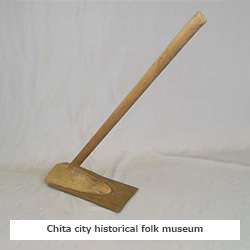
During the Edo period(1603-1867), there were a lot of artisans especially in the Chita-gun and Oono area of Aichi prefecture that specialized in making hoe’s and plow’s. These people were called Kajiya.After gaining special permission from the Shogun Ieyasu Tokugawa, they also worked in the areas of Mikawa and Mino. Among the hoe’s the Oono smiths had made there was one in particular with a wide edge weighing more than 2kg. The hoe itself and the civil engineers who used them were dubbed: ‘Kurokuwa’.

Casting: from pots and pans to cannons
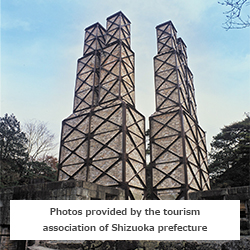
Cast metal is the cooled down and hardened product of the melting of metals at high temperature into molds made by sand and other materials.
In the Edo period(1603-1867), the casting of pots and pans was booming. Because they were transported by ship, the ‘Sanshu pots’ became famous in western Japan.The cannons produced by the Nirayama’s reverberatory furnace, which has been added to the UNESCO’s World Heritage list as a heritage of the Meiji industrial revolution, were also casted products.

Industrial steel material that supports the manufacturing industry
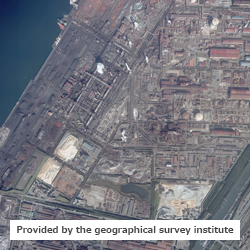
In 1916, in the Aichi prefecture, the production of special steel material by way of electrical furnaces was started.
In 1934, automatic loom manufacturing companies created a steelmaking division, and started producing steel material for automobiles. They soon continued as independent steelmaking companies. Furthermore, the steelmaking companies established in 1964 established an integrated system for iron and steel works.This iron and steel is currently supporting the manufacturing industry of Japan.

Attention: Shoryudo's latest technology
The endless innovations that Shoryudo's MONOZUKURI has brought us.
The region is always trying to go to the next level by using upgraded and diversified technology.

Provided by Mitsubishi aircraft Ltd.
MRJ(Mitsubishi Regional Jet)
The first Japan-made small people-carrier jet. A next generation regional jet made with superb operational radius and environmental compatibility to provide the best experience to its passengers. The beautiful design has also gained praise from foreign media.

The next generation automobile
The ultimate economical car called ‘Mirai’ uses fuel cells which makes hydrogen and oxygen into useable fuel. The clean and storable hydrogen leads the way for companies as the fuel source of the future. There is also a current spur on the development of self-driving vehicles.

©Central Japan Railway Company.
All rights reserved.
Superconducting Maglev
Realizes stable ultra-high speed operation at the speed of 500km/h by levitating the train 10cm above ground using magnetic force generated between the onboard Superconducting Magnet and ground coils. This next generation transportation system is expected to open in 2027 between Shinagawa and Nagoya.

Provided by Mitsubishi Heavy Industries Ltd.
Rocket development
Shoryudo is the base of Japan’s aerospace industry. All of the technology necessary for developing rockets is located in this area. Especially rocket engine parts are produced in this region. The Japan-made H-II A rocket has a successful launch rate of 96.7%, which maintains itself as the highest success rate in the world, and the ‘on-time success rate’ which makes sure the rocket launches at the specified time, is regarded as the best in the world.




